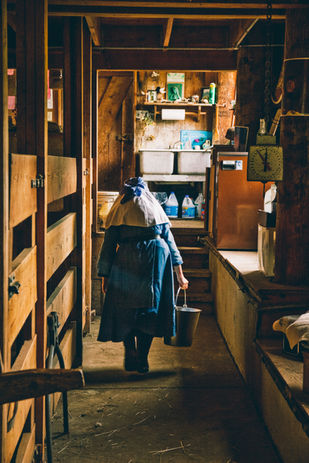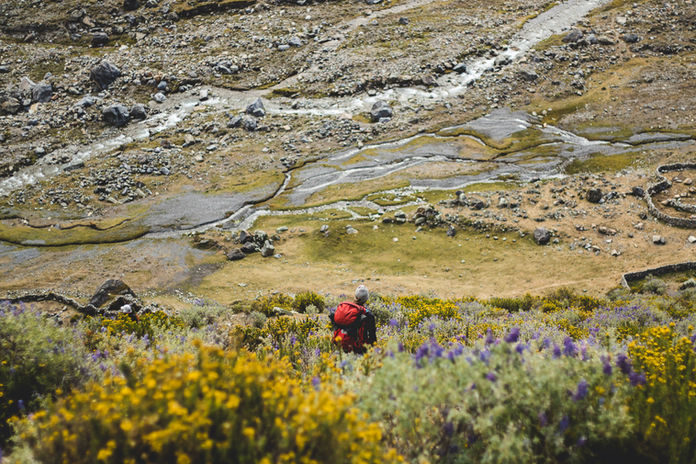Monastics - Ora et Labora
Our Lady of the Rock is a contemplative monastery comprised of seven Benedictine nuns, living their vocation of prayer and work (ora et labora in latin) in the middle of Washington state's Salish Sea on Shaw Island. Through the guidance of the ancient rule of St. Benedict, they embrace traditional methods of monastic living and farming, including donning the full habit, raising their own meat and produce, providing year-round hospitality for guests of all backgrounds, and praying the Divine Office in Gregorian chant. Viewing the seven miles of the island as their enclosure rather than the walls surrounding their cells, these "semi-cloistered" Mothers are well-known and enjoyed neighbors among the island residents as well as a famed tourist attraction within the frequently traveled San Juan Islands.
Their lifestyle is one of great commitment to the land and the sacrificing of self for the harmony of communal life and prayerful intimacy with their God. Having not received a new nun in over twenty years, the monastery's sustainability and longevity is threatened by the lack of women willing to commit to the demands and isolation of such a life. The nuns' ages currently range from their seventies to late eighties and trips off island to see the doctor are becoming a more frequent aspect of their monastic schedule. Though despite their increasing age and diminishing health and energy, the Mothers have a tremendous amount of faith that, "God will take care of this place," and continue to invest in building and sharing their wealth of knowledge with the individuals that seek them out, hoping to instill the wisdom of old with the future generations.
Read the essay I wrote reflecting on my time spent living with the nuns
Monastics - Light on a Hill
Listen to the monks singing Gregorian Chant at noon prayer
“You are the light of the world. A city on a hill cannot be hidden." Matthew 5:14
A city on a hill intending to bring light to its community near and at large is precisely the description of Mt. Angel Abbey in St. Benedict, Oregon. The Monastery was founded in 1882 by Benedictine monks from Switzerland and has since established itself as a prominent Benedictine Monastery and Seminary for men entering the priesthood in the Western United States. The Abbey is large and distinct enough that it has status as its own municipal property in which the Abbott himself rules as Mayor of town. They have their own post office, soccer field, gym, library, and café, but they are not prisoners to their holy hilltop. The monks interact with the town-folk below and run a guest retreat center, hosting visitors from all over the world. Some work with churches nearby or deliver monastery-made beer to the local stores, but they are all deeply dedicated to a disciplined life of monasticism that entails prayer and spiritual connection to God. Entering into their world felt like a time-warp - walking through arched hallways lined with golden-tiled mosaics of Christ, listening to their deep singing chant, observing Medieval illuminated manuscripts made from animal hide. The monks tap into a world that modern society is losing sight of - they are the keepers of the past, crystallizing a history that they hope won't be forgotten. But they sustain themselves with the timeless aspects of life - community, art, intellect, vocation, and time spent in nature. Their dedicated way of life has drawn men disenchanted from the fast-paced world to join their invitation of peace and prosperity outside of the confines of capitalist society.
Monuments
In December, 2017, the Trump administration revealed plans to reduce Grand Staircase-Escalante National Monument by 47% and Bear’s Ears National Monument by 85%. Grand Staircase is considered one of the last places of true wilderness in the United States, with vast areas remaining unmapped while access is limited due to rough and seasonally impassible dirt roads. Bear’s Ears was designated in 2016 as a national monument by President Obama following the proposal of the Bears Ears Inter-Tribal Coalition composed of the Hopi, Utah Diné Bikéyah, Ute Mountain Ute, Pueblo of Zuni, and Ute Indian tribes who have deep ancestral ties to the land. The monument holds over 100,000 protected Ancestral Pueblo archaeological sites.
I traveled to these monuments shortly following the Trump proclamation, hoping to grasp the significance of these lands in person before it was too late. It was a terrible kind of awe felt walking through a canyon dotted with ancestral cliff dwellings, not knowing if these ancient and sacred places’ fate would be determined by the current administration’s extractive agenda. I thought of Katie Lee, the folk singer who earned herself the title, "Goddess of Glen Canyon" from her unconventional activism work which included nude photographs of herself, a small curvy speck blending in with the massive curves of the sandstone she sought to protect from drowning under a dam. Skin on sand contact, is this a more intimate way to know a landscape? Her fight was bodily, exposing herself to expose the injustice of a lost land, saying later that they "drowned her whole guts" when they drowned 186 miles of that canyon, a whole topography forever lost. I summoned the brassy-free Katie Lee in me and lay bare in the warm red dirt, crawled over it barefoot, let my limbs twist with its curves, honoring this land through intimate touch, a kind of knowing. My sister helped get these photographs of me in the stark January cold.
Cordillera Huayhuash
The Cordillera Huayhuash is a mountain range in Peru's Northern Andes that is rapidly changing shape due to climate change. Outdoor tourism in the Andean mountain ranges was once reserved for extreme climbers and is now marketed as a hiking tour of melting glaciers - a "see it while you can" opportunity. The tourism industry supports the many small villages of farmers tucked into the folds of the mountain range, whose cows, donkeys, and horses freely roam throughout the national parks. The glaciers support them too, bringing a dependable supply of clean water. The adaptability of the Quechua people, the animals, and plants will be severely challenged as temperatures continue to rise, while foreigners travel to see the ice-sculpted backyard of their homes turn to stone.



























































































































